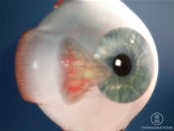Pterygium
What is a pterygium? A pterygium (pronounced tur-IJ-ee-um) is a wedge-shaped growth of conjunctiva (the surface tissue of the white of the eye) that extends onto the cornea. Pterygia are benign lesions that can be found on either side of the cornea.
What causes a pterygium to form?
UV radiation (usually from sunlight) is the most common cause of pterygium. This explains why pterygium occurs with increasing frequency in climates approaching the equator. Other causes include continuous exposure to dry, dusty environments. People who spend significant time in water sports (surfing or fishing) are particularly susceptible to pterygium because of the intense exposure to UV that occurs in these environments. When the eye is continuously assaulted by UV rays, the conjunctiva may thicken in a process similar to callus formation on the skin.
What symptoms would I have from a pterygium?
Many pterygia do not require immediate treatment if they are not causing symptoms. However, some pterygia become red and inflamed from time to time. Large or thick pterygia may bother some people due to a persistent foreign body sensation in the eye. Eventually a pterygium will start interfering with vision.
What is the treatment for a pterygium?
Evaluation by an ophthalmologist will help determine the most optimal treatment in each case. In mild cases, pterygium redness and discomfort can be controlled with lubricant eye drops (artificial tears). If a pterygium becomes intermittently inflamed, your ophthalmologist may recommend a trial of a mild steroid eye drops during acute inflammatory flares. If these drops are recommended, you should remain under the care of your ophthalmologist to ensure that you do not develop side effects from the use of these medications. When symptoms of redness, irritation, or blurred vision are resistant to conservative treatment, or when vision is affected by progressive growth of a pterygium, surgery is considered.
When should a pterygium be surgically removed?
This will depend largely on the judgment of your physician. Removal will likely be advised if the pterygium is growing far enough onto the cornea to threaten your line of vision. Pterygia may also be removed if they cause a persistent foreign body sensation in the eye, or if they are frequently inflamed and irritating. In addition, some pterygia grow onto the cornea in such a way that they can pull on the surface of the cornea and change the refractive properties of the eye, causing astigmatism. Removing the pterygium may decrease the astigmatism.
What is involved in the surgical removal of a pterygium?
The removal takes place in an operating room setting. The pterygium is carefully dissected away. In order to prevent regrowth of the pterygium, your ophthalmologist may remove some of the surface tissue of the same eye (conjunctiva) and suture it into the bed of the excised pterygium. Alternatively, an antimetabolite such as mitomycin may be applied to the site. Postoperatively, your ophthalmologist may recommend some steroid eye drops for several weeks to decrease the inflammation and prevent regrowth of the pterygium.
For more information on pterygium surgery and Specialist Eye Centre, please contact us.


